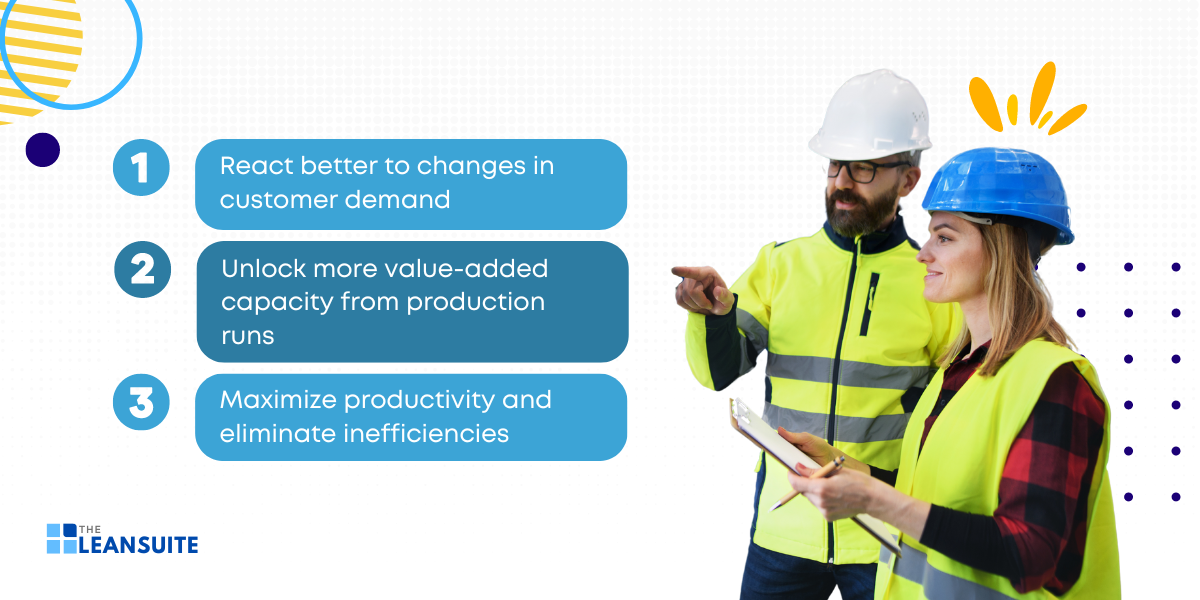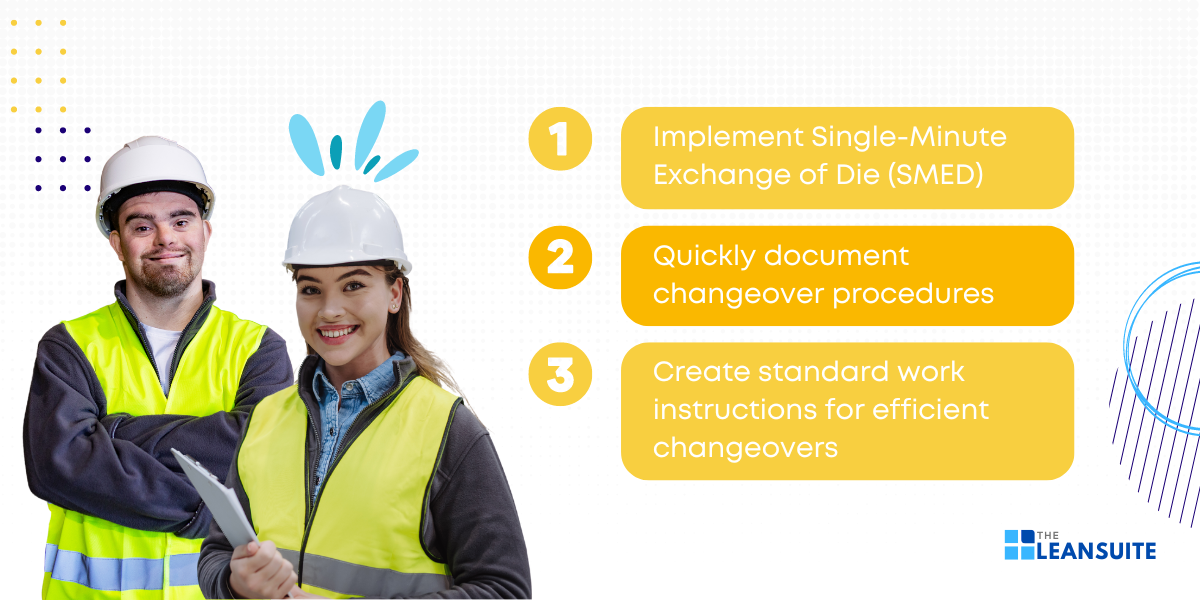Minimizing changeover time in the manufacturing industry is crucial not only for maintaining efficiency, but also for ensuring customer satisfaction. What’s more, delivering quality products consistently and on time is essential for building trust and loyalty with customers. To meet and exceed customers’ expectations, you must initiate production runs swiftly and seamlessly. In this blog post, we will explore various strategies to reduce changeover time in manufacturing, highlighting how these improvements can transform your manufacturing processes, improve customer satisfaction, and drive your business forward.
Understanding what changeover time is
Changeover time refers to the period taken to transition from producing the last item of one production run to the first item of a new run, with both meeting the required quality standards. This interval can vary depending on the industry and manufacturing process as it is influenced by the complexity and specificity of the equipment and procedures involved.
In some sectors, changeover time might be swift and straightforward, while in others, it could be complex and time-consuming. Even seemingly minor changeover durations, such as an hour a day, can greatly impact overall efficiency. This is because frequent or prolonged transitions can reduce the productive uptime of machinery and labor. Ultimately, affecting the throughput and profitability of the manufacturing operation.
How to measure changeover time
Traditionally, measuring changeover time in manufacturing environments involved a simple, but rudimentary method: pen, paper, and a clipboard.
Supervisors or operators would manually record the time taken to switch from producing one product to another. In essence, they would be capturing essential data points by hand. This method, while straightforward, was prone to inaccuracies and inconsistencies.
As industries advanced, many companies aimed to refine their measurement of changeover time by breaking down the process into more detailed tasks. These tasks included:
- Cleaning the equipment
- Changing materials
- Measuring and setting up new parameters
- Calibrating machinery
- Performing maintenance
- Running the first batch of good material
- Conducting quality checks
These task breakdowns aimed to provide a more detailed view of the changeover process, highlighting areas for improvement and efficiency gains.
However, the manual nature of recording these tasks posed significant challenges. Data often became inaccurate due to human error. For instance, numbers were excluded, rounded, or omitted entirely. Therefore, this inaccuracy made it difficult to obtain a true picture of changeover time. As a result, this hindered efforts to optimize production.
The modern approach to calculating changeover time
To address these issues mentioned above, modern manufacturing environments increasingly rely on automated systems to measure changeover time.
Automated machine data platforms capture real-time data with precision, eliminating the inaccuracies associated with manual recording. Moreover, by leveraging technology, companies can obtain a more accurate and comprehensive picture of their changeover times. Consequently, this leads to more effective strategies for reducing downtime and improving efficiency.
In sum, the most accurate way to measure changeover time is through the use of a machine data platform. This ensures reliable and actionable insights for continuous improvement.
Essential factors to consider when calculating changeover time
Regardless of the method used, certain factors must always be included in changeover time calculations to get a comprehensive view of its impact. These factors include lost labor cost, product cost, and recovery costs.
1. Lost labor cost
To calculate lost labor cost, determine the number of workers involved multiplied by their hourly wage multiplied by the total number of hours lost or expended in the changeover.
For instance, if there are 2 workers involved with an hourly wage of $20 each and the entire changeover process takes 2 hours, the lost labor cost would be 2 x $20 x 2 = $80.
2. Product cost
This involves calculating the cost of products that could have been produced during the downtime.
To find this, multiply the number of units typically produced per hour by the cost per unit, and then by the downtime duration.
For example, if 100 units are produced per hour and each unit costs $5, the product cost for 2 hours of downtime is 100 x $5 x 2 = $1,000.
3. Recovery costs
Recovery costs include any additional expenses incurred to bring the production back to its normal state. For example, this may involve overtime pay, expedited shipping for materials, or additional quality checks.
To calculate this, sum up all these extra costs incurred due to the downtime.
The benefits of reducing changeover time in manufacturing
Reducing changeover time in manufacturing is a game-changer for efficiency and productivity. In this section, we’ll explore the top three benefits that come from streamlining this critical process.

1. React better to changes in customer demand
Reducing changeover time in manufacturing helps you to better react to changes in customer demand.
By eliminating as many changeover steps as possible, you can facilitate improved changeover times, leading to enhanced flexibility and responsiveness. This agility allows you to produce smaller batch sizes more efficiently, ensuring that you can quickly adapt to market fluctuations and meet customer needs with greater precision.
Consequently, this capability boosts operational efficiency and enhances customer satisfaction by providing timely and tailored products.
2. Unlock more value-added capacity from production runs
Reduce changeover time in manufacturing to unlock more value-added capacity from production runs.
When equipment spends less time idle during changeovers, overall productivity increases significantly. By minimizing the downtime associated with switching from one task or product to another, you can reduce production batch sizes, and even efficiently produce single-piece lot sizes. This flexibility enables a more responsive production process, allowing quicker adaptation to changing market demands and reducing inventory costs.
As a result, the streamlined operations enhances throughput and improves the quality and variety of products offered. Ultimately, maximizing the value derived from each production run.
3. Maximize productivity and eliminate inefficiencies
Reducing changeover times is crucial for maximizing productivity, as it directly increases the number of units produced within a given day.
By minimizing the duration needed to switch between different production processes, tasks or batches, you can significantly boost your operational efficiency and output.
Moreover, changeover time is classified as ‘Waiting’, one of the eight types of waste identified in Lean process management, or also known as Lean manufacturing. Reducing this waiting time not only enhances production flow, but also contributes to higher overall production value. This is because it eliminates inefficiencies and ensures continuous, streamlined operations.
How to reduce changeover time in manufacturing
Reducing changeover time in manufacturing is a game-changer for efficiency and productivity. In this section, we’ll explore the top three benefits that come from streamlining this critical process.

1. Implement Single-Minute Exchange of Die (SMED)
Implementing the Single-Minute Exchange of Die (SMED) system, developed by Dr. Shigeo Shingo, is highly effective in reducing changeover time in manufacturing.
This innovative system focuses on drastically decreasing equipment changeover times, aiming to complete these transitions within single-digit minutes, ideally nine minutes or less. By separating internal and external setup tasks, standardizing functions, and simplifying operations, SMED enables you to streamline processes, minimize equipment downtime, and increase overall productivity.
This approach enhances efficiency and allows for greater flexibility in production schedules. Therefore, leading to more responsive and competitive manufacturing operations.
2. Quickly document changeover procedures
To swiftly document changeover procedures and reduce changeover time in manufacturing, it is essential to start by observing or recording current operations meticulously. Doing so allows you to capture a clear and accurate picture of the existing process.
Once documented, break down each production process into smaller, manageable steps. Assess each step critically, asking if any tasks can be performed differently or more efficiently. In essence, this granular analysis helps identify bottlenecks and opportunities for improvement.
By systematically examining and refining each component of the changeover process, you can implement streamlined procedures that minimize downtime and boost overall productivity.
3. Create standard work instructions for efficient changeovers
Creating standard work instructions, also known as Standard Operating Procedures (SOPs), is crucial for reducing changeover times. These instructions serve as the most effective method for streamlining procedures and ensuring consistency across operations.
By documenting each step of the changeover process in detail, employees can follow a uniform approach. As a result, this minimizes variations and errors that often lead to delays. Additionally, SOPs facilitate training and skill development. This, in turn, enables workers to perform tasks efficiently and confidently.
In short, standardizing work through SOPs not only speeds up changeovers, but also enhances overall productivity and quality. Thus, fostering a more efficient and reliable manufacturing environment.





